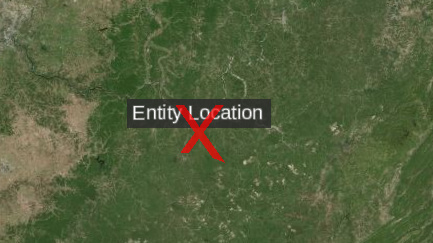Getting rid of imageSubRegion: new BoundingRectangle(27, 103, 22, 22), made it appear; using eyeOffset: new Cartesian3(0.0, 0.0, -10.0), made it appear more readily. It’s still getting stuck a bit into the terrain, but it’s visible:

Interestingly, the eyeOffset’s value determines how close one can get to the Earth before it disappears completely…if it’s -10, you can get 10 metres away before it disappears; if it’s -100, you can get 100 metres away before it disappears; etc. That’s not related to the terrain, but rather the camera’s distance to the object in question.
EDIT:
You can completely prevent it from clipping by using disableDepthTestDistance, which I’ve set to the diameter of the Earth (after which it begins to clip)


For those looking, my entity creation looks like:
viewer.entities.add({
name: 'Marker of Entity Location',
id:'marker',
position : worldPosition,
billboard : {
color : Color.RED.withAlpha(0.7),
image: "/resources/images/x.png",
scale: 0.2,
eyeOffset: new Cartesian3(0.0, 0.0, -10.0),
heightReference: HeightReference.CLAMP_TO_GROUND,
verticalOrigin: VerticalOrigin.CENTER,
horizontalOrigin: HorizontalOrigin.CENTER,
disableDepthTestDistance: 1.2742018*10**7 // Diameter of Earth
},
label: {
text: "Entity Location",
font: "20px sans-serif",
showBackground: true,
eyeOffset: new Cartesian3(0.0, 0.0, -10.0),
horizontalOrigin: HorizontalOrigin.CENTER,
pixelOffset: new Cartesian2(0.0, -20.0),
pixelOffsetScaleByDistance: new NearFarScalar(
1.5e2,
3.0,
1.5e7,
0.5
),
disableDepthTestDistance: 1.2742018*10**7
},
});
Thank you for all the help!


 First convert the Cartesian to a Cartographic, then pull height (in meters), add the amount (ie. +0.2), and convert back to Cartesian and update the position. It’s tedious, I don’t know if there’s a simple way to do it, maybe some of the Cesium guys can pipe in here.
First convert the Cartesian to a Cartographic, then pull height (in meters), add the amount (ie. +0.2), and convert back to Cartesian and update the position. It’s tedious, I don’t know if there’s a simple way to do it, maybe some of the Cesium guys can pipe in here.






